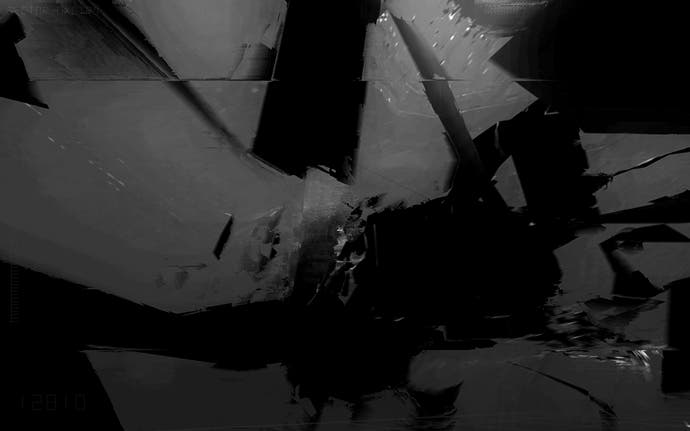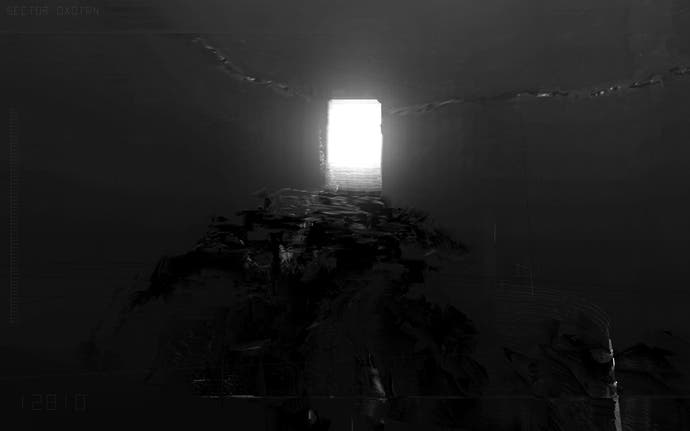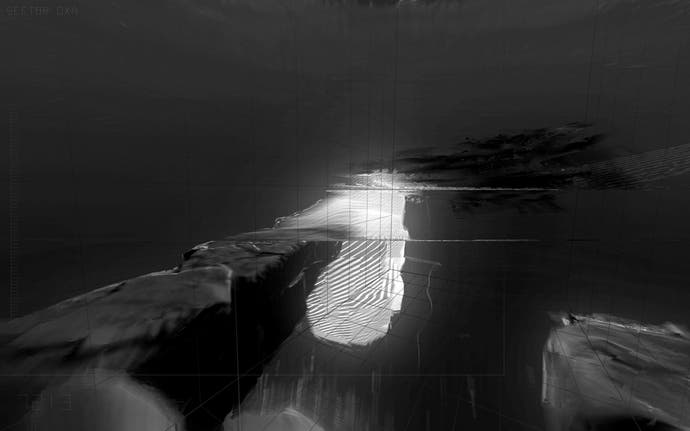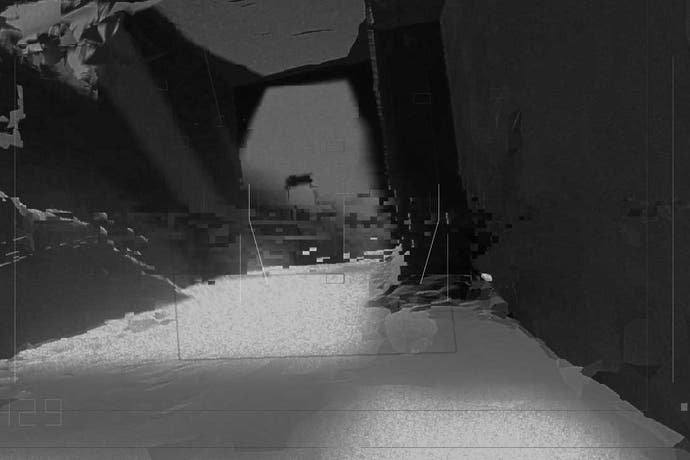The art of noise: Inside Memory of a Broken Dimension
Ezra Hanson-White discusses the archaeology of the future.
A good game draws you through the screen.
You know this feeling: your surroundings bleed away, peripheral noises grow quiet, and you're suddenly inside the machine, keyboards or controllers long forgotten, pushing into the ether as you head from one decision to the next.
Ezra Hanson-White's new game takes this sort of thing fairly literally. You load it up and you're confronted with a black background and shimmering grey text. A command line awaits. What do you type?
Well, what did you used to type? Hack your way around the system for a few minutes and exciting things start to happen: strange files are downloaded, and you're invited to explore them. So far you're still outside the screen, peering in. You're role-playing yourself, in essence - a lone figure tapping away at an odd interface, trying to make sense of it all, trying to progress. Then you hit the jackpot. Everything starts to scroll, figures and symbols rushing past. It's a sudden eruption of data. The soundtrack, formerly shifting tones and chattering bursts of static, begins to build to a jet-engine crescendo, the occasional glitches that have rattled across the text increase in frequency. The code becomes a syringe pushing you forwards, the light starts to fragment and then - black out. You're somewhere else.
You're inside.

Even in its current demo build, Memory of a Broken Dimension is a stark and wonderful thing - sprawling, fidgety, often frightening. It's also strangely coherent: a computer game about computers themselves, the message turned inwards to comment, however obliquely, on the medium. Its opening sequence may not be particularly friendly to new players, but it will strike a note with anyone who remembers the early days of home PCs - the days before the interface cleaned everything up and made everything accessible. If the game is a mystery, it's because it's channeling the inherent mysteries of the machines it runs on: we made them, but they do not feel like they are of us. What are they exactly, then?
Hanson-White has been working around computers - and working in games - for about a decade. After stints at both Gearbox and Monolith, he's now in Seattle with Camouflaj. By day, he's helping to build Republique, Ryan Payton's cinematic stealther blessed with a name that, for some reason, makes it sound like a fancy brand of ladies trousers. By night, though? I like to think he's piecing Memory of a Broken Dimension together at night. It feels like a game made after dark, anyway, emerging naturally from the ghostly glow of the monitor.
"I can't remember the first video game I played, but I can remember the early days of using computers," Hanson-White tells me over the static and buzz of a Skype call. "You're using DOS, you'd have boot disks that you'd have to make to get certain games to run because there wasn't enough memory. It was just this huge ordeal just to get a game to run. This game that you're really excited to play. You'd have to explore, then it wouldn't work, and there would be bugs and you'd have to do things with your computer to get it to work as it should. That's definitely influencing some of the mysteries of the project.

"Today everything is just so much more accessible," he sighs wistfully. "People have common languages for explaining things. It's a little less mysterious now. It's probably the same with the internet. Especially when I was younger. It just seemed a little bit impossible: these computers are connected to all these other computers. You get that exploration feeling: where did it come from, what's inside of it, who made that? I'd like to capture some of that. With Memory, my approach has been that it would be amazing if I could send people the game anonymously on some weird looking USB drive - no documentation or anything. Even without that happening, I'm sticking with this idea that it's a computer emulator that's become a weird legend on the internet. People are sending it to each other but nobody knows where it came from."
This 'legend' aspect might explain why Memory's so fascinating, why it's been pinging around the Eurogamer office for the last few weeks captivating everyone who sees it. The game Hanson-White's building doesn't really feel like a game: possessed with a distinct Demoscene vibe, it's more of a cool, confusing, somehow ancient thing that you found. A virtual sculpture. A program that can take you to weird places.
But the weird places themselves - the worlds shifting and rattling behind that command line - are influenced by things that lay outside of early computing experiences. "There have been lots of different elements that have affected the idea and have contributed to how it's grown in my head," admits Hanson-White. "There's always been a lot of influence from space exploration stuff with the rovers they sent to Mars. To me, it ties into the idea that you're using the internet and you're watching a streaming video in the late '90s. You're getting lag and the connection drops and then suddenly you're seeing all these compression artefacts and the image is stretching. It's unintended, but it's still interesting-looking. I just wanted to play around with the idea of doing something that has really distorted visuals and could be related to ideas from space exploration or archaeology: you're exploring a space that you're unfamiliar with and you're not really sure where it is.
"That ties into a lot of influences from pop culture cyberpunk stuff. I really like Neuromancer. Then there's an artist, Tsutomu Nihei, and most of his work is these really huge, gigantic structures. It's never explained who built these structures - they're just there for the characters to explore and see what's in them. Even related to that there's the Pyramids in Egypt, old megalithic structures like Stonehenge. They've all got the same kind of wonder behind them and I want to capture that with the game."
Inevitably, then, Memory is a game rooted in exploration. Once you break through the barrier of the command line, you look up to find yourself in three-dimensional space - a distorted, artefact-riddled stormworld where the ground is latticed with grid lines and the sky is torn and ragged with static.

It's a rather scary monochrome vision of cyberspace, a decayed and lo-fidelity alternative to the sleek edges of Tron. As you move around inside it you may initially find yourself wondering how much you can take. Every few steps - if steps are even the right concept as you ghost over the shifting ground, leaving a bright white line of data behind you - the landscape buzzes, the screen threatens to collapse in on itself, and you can almost feel the sensation of an electric shock every now and then. It's thrilling to be here, but it's also exhausting: it's like rattling about inside a migraine.
This is a digital world, though, and the rules that control it turn out to be reassuringly straightforward. All around you are shattered spars of geometry, flashing and flickering in suspension. If you find the right spot where your perspective brings them all together as a single object, you can click the mouse to lock them in place - to synchronise them in Hanson-White's words - and transform them into a physical object.
Architecture! Satisfying aural feedback guides you through learning the simple rules at play, and within a few moments, you're navigating the world one discrete chamber at a time, syncing handy pieces of the environment together and then using them to explore.
"The real root of the actual game mechanics was that I was just messing with visual effects a long time ago, and I saw this perspective trick," recalls Hanson-White. "It's been used in paintings. The artist will draw in an object, and you won't be able to see it if you're looking at the painting straight on. Then, if you're looking at a specific angle, though, you'll see there's like a skull or something hidden in the painting. I found that interesting, and I guess in some ways it's similar to the visual tricks someone like Escher might use. I wanted to see if there's a way I could do that with 3D geometry. I wasn't really sure if it would work at all. It's just always been a thought in the back of my mind."
While it makes for a bracingly simple blend of puzzling and platforming - if you're really stuck, you can even track down spindly little nodes on the map that give you a brisk audio cue when you're in the right position to sync something - it also ties into one of the game's most fascinating preoccupations, the relationship between virtual data and physical objects.

It's a relationship that Hanson-White finds tricky to explore in words alone. "I think this kind of gets at the idea that, say, scientists are looking at information from the Curiosity rover on Mars," he begins tentatively. "What if they had to work through these weird glitches to the data that happen during the transitions? Maybe they understand why it's happening, but there's this process to eliminate the glitches before they can actually see or use the data. That's what I find interesting about it.
"I guess in general when you're doing research, you're capturing data and analysing it," he continues. "There's often clean-up involved: getting rid of noise and boosting signal quality. Having the geometry being fragmented and then allowing you to synchronize it together and make it physical, it's my take on all of that."
From this conceit - capture chunks of the landscape and then use them to strike out into the unknown - Hanson-White's hoping to build a relatively traditional structure as the player learns new skills for manipulating data, thus opening up additional parts of the environment. He's also hoping that as the audience begins to tune in to geometry in need of synchronisation, they'll also be picking up traces of a narrative that will bring the whole thing together.
"What I've been trying to do is get everything planned out for when I'm ready to go full-speed on the project with full-time work," he explains when I ask how far the game has moved beyond the current playable demo. "I'd say there is a story at work, and the interesting thing is that it's all based around the player themselves. You're not playing as a character from the first-person view, you're just you using the computer. There will be programs and tools that will be presented to you, and it's up to you to piece things together and figure out what their uses are.

"Overall, without being too spoilery, the intended narrative is that this computer system has a purpose. It's unknown to the player when they start interacting with it, but then, over the course of the game they discover tools that weren't available to them, they piece things together, start to see the bigger picture, and they start to form an opinion of what the computer system is used for. I'm not sure the game will ever outright explain what's going on, but I'd like to drop enough fictional hints in to help the player paint a picture of what this is. The player has to be imaginative."
The fact that such a disorientating space does encourage you to be imaginative is just one achievement amongst many, I'd argue. I've been playing Hanson-White's prototype build for a week or two, and I'm still surprised to discover that, each time I turn it off, I emerge back in the real world blinking and rather muddled. It's like pulling your head out of a washing machine drum after poking around inside for a stray sock, or stepping from a plane following a lengthy flight. Everyday life suddenly feels bright and vast and open: the physical environment seems to have changed a little.
Memory of a Broken Dimension has still got a long way to go, in other words - but it should definitely be a journey worth taking. And that's regardless of where it deposits you once it's all over.

